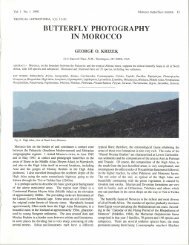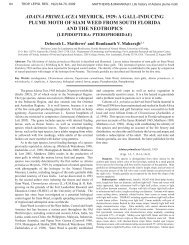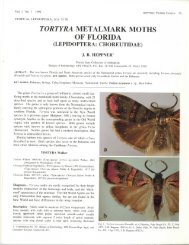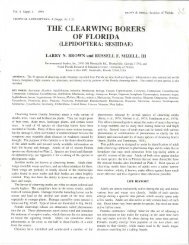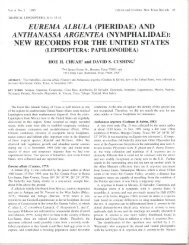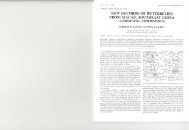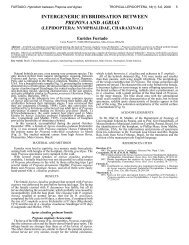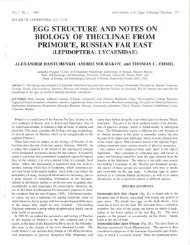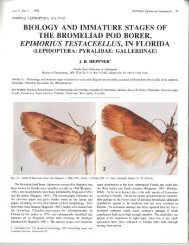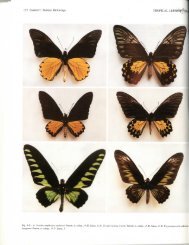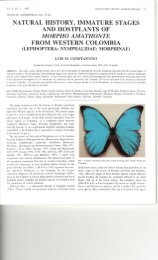LEFT PAGE.- Fig. 1 - Association for Tropical Lepidoptera
LEFT PAGE.- Fig. 1 - Association for Tropical Lepidoptera
LEFT PAGE.- Fig. 1 - Association for Tropical Lepidoptera
You also want an ePaper? Increase the reach of your titles
YUMPU automatically turns print PDFs into web optimized ePapers that Google loves.
<strong>LEFT</strong> <strong>PAGE</strong>.- <strong>Fig</strong>. 1 (top left) Catasticta sp. (Pieridae), Boyaca, Colombia, A. R. Amarillo and C. E. Sarmiento (Bogota, Colombia). 2. (top right) Eligma narcissus<br />
(Noctuidae), Vietnam, K. Spitzer (Ceske Budejovice, Czechoslovakia). 3. (center left) Thyridia sp. (Nymphalidae: Ithomiinae), Rondonia, Brazil, D. Petr (Keene, Texas).<br />
4. (center right) Eumaeus atalaflorida (Lycaenidae), Florida, USA, M. C. Minno (Gainesville, Florida). 5. (lower left) Graphium agamemnon (Papilionidae), Malaysia,<br />
H. H. Chuah (Houston, Texas). 6. (lower right) sp? (Dalceridae), Rondonia. Brazil, D. Petr (Keene, Texas).<br />
RIGHT <strong>PAGE</strong>.- <strong>Fig</strong>. 7. (upper left) Chrysocale sp. (Arctiidae: Ctenuchinae), Boyaca, Colombia, A. R. Amarillo and C. E. Sarmiento (Bogota, Colombia). 8. (upper right)<br />
Dirphiopsis'! sp. (Saturniidae), Rondonia, Brazil, D. Petr (Keene, Texas). 9. (center left) Cupha erymanthis (Nymphalidae), Hong Kong, J. J. Young (Hong Kong).<br />
10. (center right) Lonomia cynira (Saturniidae), San Luis Potosi, Mexico, J. K. Adams (Dalton, Georgia). 11. (lower left) Crypsiphora ocultaris (Geometridae), South<br />
Australia, N. McFarland (Here<strong>for</strong>d, Arizona). 12. (lower right) Urania sp. (Uraniidae), Rondonia, Brazil, L. Groce (Gainesville, Florida).<br />
COVER PHOTOS: cover photographs (except front cover) are also honorable mentions from the Photo Contest.
HONORABLE MENTION
Vol. 3 No. 2 1992 BROWER et al.: Anetia and the Danainae 65<br />
TROPICAL LEPIDOPTERA, 3(2): 64-73<br />
LIFE HISTORY OF ANETIA BRIAREA<br />
AND ITS BEARING ON THE EVOLUTIONARY<br />
RELATIONSHIPS OF THE DANAINAE<br />
(LEPIDOPTERA: NYMPHALIDAE)<br />
LINCOLN P. BROWER1, MICHAEL A. IVIE2, LINDA S. FINK',<br />
JOHN R. WATTS4 and RAYMOND A. MORANZ1<br />
Department of Zoology, University of Florida, Gainesville, FL 32611, USA1<br />
Department of Entomology, Montana State University, Bozeman, MO 59717, USA2<br />
Department of Biology, Sweet Briar College, Sweet Briar, VA 24595, USA1<br />
Department of Entomology, University of Florida, Gainesville, FL 32611, USA4<br />
ABSTRACT.- Wild captured Anetia briarea females oviposited on, and their larvae ate, Cynanchum angustifolium, a milkweed vine (Asclepiadaceae).<br />
Contrary to the early literature, 2nd through 5th instar larvae bear a pair of well developed dorsal tubercles on their mesothorax. This and several<br />
other larval and chrysalid characters question Ackery and Vane-Wright's (1984) placement of the genus Anetia in the largely Old World tribe<br />
Euploeini, as well as its relationship to the genus Lycorea. Several larval and chrysalid characters seem closer to those of the tribe Danaini. Forbes<br />
(1939) may well have been correct in placing Anetia at the base of the subfamily Danainae. The new findings have major evolutionary and<br />
taxonomic implications <strong>for</strong> the milkweed butterflies.<br />
KEY WORDS: Amauris, Apocynaceae, Asclepiadaceae, behavior, biogeography, Central America, chemical defense, Danaina, Danaini, Danaus,<br />
Dominican Republic, Euploea, Euploeina, Euploeini, evolution. Greater Antilles, Hispaniola. hostplants, Idea, Ideopsis, immature stages, Ithomiinae,<br />
Itunina, larval morphology, Lycorea, Lycoreini, Mexico, milkweed butterflies, Neotropical, Parantica, parasites, Pinaceae, Protoploea, pupa, Taiwan,<br />
taxonomic characters, Theophrastaceae. Tirumala, West Indies.<br />
A central unresolved question in Ackery and Vane-Wright's aggregations on Finns accidentally Swartz (Pinaceae) located on<br />
(1984, hereafter referred to as A&VW) comprehensive review of Pico Duarte in the Dominican Republic, Hispaniola. This area is<br />
the Danainae is the systematic position of the genus Anetia. In described in detail by Ivie et al. (1990). Specimens were netted<br />
addition, Anetia dominates New World Danaines in terms of the from a single aggregation, placed individually in glassine<br />
number of species in its genus: only 14 of the 157 known species envelopes, and transported by mule back to base camp on 3 July,<br />
of the Danainae occur in the New World, and five of these are and then flown to Bozeman, arriving on 10 July. Ten females<br />
within the genus Anetia. Despite this New World diversity and and 8 males were packed on artificial ice in an insulated box, and<br />
the systematic importance of the genus, practically nothing is shipped overnight to Gainesville. Upon receipt at 3 PM (1500 hr)<br />
known of the life histories of any of its members. A&VW and on 16 July, the butterflies were released into an outdoor 11m long<br />
Kitching (1985) underscore the acute need <strong>for</strong> such in<strong>for</strong>mation. x 5m wide x 4.5m high screened flight cage on a hot sunny day.<br />
We show here that the historical description of the larva of A. The ambient shade temperature was 35°C. Unexpectedly, the<br />
briarea (purported lack of tubercles, a black head, etc; see Poey, butterflies entered heat shock and so were immediately transferred<br />
1846-47: Gundlach, 1881; Brown and Heineman, 1972; Riley. to an air-conditioned room with fluorescent lighting where they<br />
1975; A&VW, p. 244) is erroneous and that several new larval were held at approximately 25°C.<br />
characters, together with the very Danaus-\ike morphology of the<br />
chrysalid, challenge A&VW's tentative systematic placement of INITIAL ATTEMPTS TO OBTAIN EGGS ON VARIOUS<br />
the genus.<br />
ASCLEPIADACEAE: Asclepias, Cynanchum and Matelea<br />
We first tried to obtain eggs by enclosing one-three females in<br />
REARING STOCK AND BIOLOGY<br />
3 x 5cm black silk organza bags over apical blooming stems of<br />
potted Asclepias curassavica L. plants in the air conditioned<br />
Anetia briarea Godart (Nymphalidae, Danainae) (<strong>Fig</strong>. 1) butter- room. These plants were derived from the Miami, Florida area<br />
flies were collected in July 1992 from high altitude (3000m) described in Malcolm and Brower (1986). Each day the butter-<br />
FRONTISPIECE: Mature fifth instar larva of Anetia briarea (Danainae) feeding on Cynanchum angustifolium (Asclepiadaceae). Contrary to the literature, A. briarea larvae<br />
possess a pair of tentacles on the mesothoracic segment. © L.S. Fink 1992.
66 BROWER et al.: Anetia and the Danainae TROPICAL LEPIDOPTERA<br />
<strong>Fig</strong>. 1. Anetia briarea from Pico Duarte, Dominican Republic (top = dorsal; bottom = ventral). Specimens collected by M.A. Ivie, 1988. © L.P. Brower 1992.<br />
flies were removed and individually fed sucrose solution.<br />
Notwithstanding frequent agitation, the females exhibited no<br />
oviposition behavior from 16-19 July. On 19 July, we collected<br />
a flowering Matelea sp. vine from Gainesville (Alachua County,<br />
Florida), sealed its cut end in a vial of water and added it to one<br />
of the organza bags containing three females and A. curassavica.<br />
The females still laid no eggs.<br />
On 20 July, we collected flowering Asclepias lanceolata Walt,<br />
plants growing in the freshwater marshy areas east of Cedar Key,<br />
Levy County, Florida. We also collected Cynanchum angustifolium<br />
Pers. at Cedar Key. The identification of C. angustifolium<br />
(Rosatti, 1989, p. 484) was verified by Kent Perkins of the<br />
University of Florida Herbarium, to which we donated three<br />
voucher specimens (Accession No. FLAS 175989); one of these<br />
will be sent to the British Museum (Natural History), London.<br />
According to Correll and Johnston (1970), C. angustifolium is<br />
synonymous with C. palustre (Pursh) Heller. At Cedar Key this<br />
small-leafed milkweed vine twines about the salt marsh grasses<br />
and grows in a narrow zone (about 10m in width) immediately<br />
above the high tide line. Burns (1988) reported this plant as a<br />
host of both Danaus gilippus (Cramer) and D. plexippus L. in<br />
North Carolina, and we saw several D. g. berenice ovipositing on<br />
it at Cedar Key. Several vines were collected that were flowering<br />
and in bud. To avoid wilting, the bases of the cut stems of<br />
Matelea, A. lanceolata and C. angustifolium were wrapped in wet<br />
paper. These three asclepiads were then put inside a one gallon<br />
clear plastic bag that enclosed the apical flowering portions of the<br />
potted A. curassavica plant. Thus the three females had access<br />
to four diverse milkweed species. On 22 July, one female laid<br />
approximately five eggs on the Cynanchum leaves and stems.<br />
SUCCESSFUL OVIPOSITION METHOD<br />
On 23 July, we put three, two, and one female in separate<br />
plastic bags, each containing at least one stem with leaves, buds<br />
and flowers of each of the above four milkweed species. One<br />
bag at a time, with an inserted thermometer, was then taken into<br />
full sunlight and allowed to heat to
Vol. 3 No. 2 1992 BROWER et al.: Anetia and the Danainae 67<br />
<strong>Fig</strong>. 2. Early fifth instar larva (#7) feeding on a leaf of Cynanchum angustifolium.<br />
Total length = 3.1cm. © L.S. Fink 1992.<br />
transferred to half pint clear plastic containers to which wet paper<br />
wads were added to prevent desiccation.<br />
LARVAL REARING AND SURVIVAL<br />
The first egg hatched on 24 July and was given a fresh Cynanchum<br />
stem and a fresh apical cutting of A. curassavica. Both<br />
plants had leaves, buds and flowers. This larva became cataleptic<br />
(cf. Zalucki and Brower, 1992) after nibbling one or the other of<br />
the foodplants and thereafter refused to eat. On 25 July, five<br />
eggs hatched and were given one fresh leaf each of A. curassavica,<br />
A. incarnata L., A tuberosa L., and Cynanchum, as be<strong>for</strong>e.<br />
The A. incarnata plants were from Miami stock (Malcolm and<br />
Brower, 1986) and the A. tuberosa were commercially obtained<br />
nursery stock. One larva which nibbled A. curassavica, and<br />
another which sampled A. incarnata, went cataleptic, but a third<br />
began eating the Cynanchum stem and produced normal looking<br />
frass. By 26 July, three larvae were successfully eating Cynanchum<br />
leaves, buds, and/or stems. We then removed all the<br />
Asclepias leaves because the larvae did not eat them and we<br />
expected them to die if they attempted to do so. On 28 July we<br />
had five first instars. By 29 July, two of these apparently had<br />
been cannibalized. All remaining larvae were there<strong>for</strong>e isolated.<br />
Several eggs failed to hatch and probably were infertile.<br />
On 29 July we had six first through fourth instar larvae<br />
feeding on Cynanchum, maintained at approximately 24°C under<br />
a 16hr light/ 8hr dark regimen. Plant consumption was slow, and<br />
several first and second instar larvae stopped eating and died,<br />
suggesting that C. angustifolium is marginal as an A. briarea<br />
foodplant. We successfully reared two larvae through the fifth<br />
instar. One (hereafter called Larva #3) that hatched on 27 July<br />
(day 1) was second instar on day 3, third on day 5, fourth on day<br />
9, and fifth on day 14. It spun up to <strong>for</strong>m its chrysalid late on<br />
day 19 and was preserved early in its prepupal stage on the<br />
morning of day 19. <strong>Fig</strong>ures 4 and 5 show Larva #3 in its late<br />
fourth instar on day 13. The frontispiece is Larva #3 late in its<br />
fifth instar on day 18, one day be<strong>for</strong>e its prepupal stage. The<br />
second larva (hereafter called Larva #7) became fourth instar on<br />
29 July, and fifth on 6 August. <strong>Fig</strong>ures 2 and 7 are Larva #7<br />
photographed on 8 August, and <strong>Fig</strong>. 6 and 8 are Larva #7<br />
photographed on 9 August. The prepupa <strong>for</strong>med from Larva #7<br />
on 12 August (<strong>Fig</strong>. 9), and <strong>for</strong>med its chrysalid on 13 August.<br />
<strong>Fig</strong>ures 10-12 are this chrysalid photographed on 15 August, and<br />
<strong>Fig</strong>. 13 is the same individual (backlit) photographed on 16<br />
August. Based on the size of A. briarea as an adult, we judged<br />
that the fifth instar larvae and the chrysalid were about 2/3 of the<br />
size they would have attained had they been reared on their native<br />
Hispaniolan foodplant(s). The three day old chrysalid was<br />
preserved on 16 August.<br />
The larvae, prechrysalid, and chrysalid were photographed<br />
using a Nikon 8008 with a 105mm Micro Nikkor lens and<br />
through-the-lens flash or natural lighting, using Fujichrome 50 or<br />
100 film. The egg was photographed with a Wild M-32 microscope,<br />
artificial lighting, and Kodachrome 64 film. The adults<br />
were photographed in natural sunlight on Kodachrome 25 with a<br />
Leicaflex R-3 and a 60mm Macro-Elmarit lens.<br />
Unhatched eggs, first, second, and fourth instar larvae that<br />
died, one late fifth instar larva (Larva #3) and one chrysalid<br />
(Larva #7) were preserved in ethanol and shipped to the British<br />
Museum <strong>for</strong> cladistic analyses. Several second through fourth<br />
instar larval head capsules were also preserved and included in<br />
the shipment.<br />
POSSIBLE FOODPLANTS IN HISPANIOLA<br />
One reason <strong>for</strong> the uncertain systematic position of the genus<br />
Anetia within the Danainae is the lack of documented foodplants<br />
(review in A&VW, 1984). Our success in inducing Anetia<br />
briarea to oviposit on Cynanchum angustifolium and in rearing<br />
two of about 25 larvae successfully on this milkweed bolsters the<br />
weak evidence that supports the Asclepiadaceae as Anetia foodplants<br />
(A. thirza, A&VW, p. 243; DeVries, 1987, p. 214; A.<br />
briarea, Wetherbee, 1989; A. pantheratus, Wetherbee, 1991). As<br />
noted above, A. briarea did not accept Matelea sp., Asclepias<br />
curassavica, A. incarnata, A. lanceolata, or A. tuberosa, either<br />
<strong>for</strong> oviposition or as a larval foodplant, and the two Asclepias<br />
species that they nibbled (A. curassavica and A. incarnata)<br />
seemed toxic to the first instar larvae.<br />
Many larvae failed to develop successfully on Cynanchum<br />
angustifolium. This strongly suggests that different non-Asclepias
68 BROWER et al.: Anetia and the Danainae<br />
TROPICAL LEPIDOPTERA
Vol. 3 No. 2 1992 BROWER el a I.: Anetia and the Danainae 69<br />
milkweeds serve as foodplants <strong>for</strong> A. briarea in their native<br />
habitats. According to Moscoso (1943), approximately 31<br />
endemic species in nine genera of the Asclepiadaceae occur on<br />
Hispaniola, together with six introduced species in five genera.<br />
The endemics include two species of Asclepias (A. curassavica<br />
and A. nivea), one Astephanus, one Funastrum (= Sarcostemma),<br />
three Gonolobus, one Ibatia (= Cynanchuml), seven Marsdenia,<br />
twelve Metastelma, three Poicillopsis, and one Tainionema', the<br />
introduced species are in Calotropis, Hoya, Cryptostegia,<br />
Stapelia, and Stephanotis.<br />
Sorting out which of these asclepiads are natural Anetia foodplants<br />
will require further field research. Since the generic<br />
classifications of these milkweeds are in flux (cf. Correll and<br />
Johnston, 1970; Long and Lakela, 1971; Wunderlin, 1982;<br />
Clewell, 1985; Judd, 1987; Rosatti, 1989), the task will be<br />
<strong>for</strong>midable. It is essential that the plant specimens upon which<br />
oviposition occurs and upon which larvae feed successfully be<br />
pressed, documented, and deposited in appropriate museum<br />
herbaria.<br />
Our new data render dubious the often quoted A. briarea larval<br />
foodplant as Jacquinia in the family Theophrastaceae. It is likely<br />
that Jacquinia was the substrate bush upon which an asclepiad<br />
vine was growing (Ivie, personal observations).<br />
SYSTEMATIC IMPLICATIONS<br />
Although the most probable systematic placement of A. briarea<br />
based on characters of the immatures will have to wait <strong>for</strong><br />
analysis of the material that we have <strong>for</strong>warded to the British<br />
Museum (Natural History), London (Kitching et al., in prep.), our<br />
preliminary examination allows us to comment on several<br />
questions raised in the literature.<br />
A. Is Anetia a Danaine? Early authors vacillated over whether<br />
Anetia should be included with or excluded from the Danainae<br />
(A&VW, pp. 2-7, 60). Although a general consensus has<br />
converged on including the genus, A&VW note that as recently<br />
as the 1970's lepidopterists were not consistent in their recognition<br />
of this. A&VW (p. 17) include the genus on the basis of the<br />
male hair pencils. Our rearings of A. briarea confirmed two<br />
additional larval features consistent with their placement in the<br />
Danainae:<br />
1) Larval tubercles: Anetia briarea larvae have a pair of<br />
tubercles on the mesothorax (postcephalic segment 2), but none<br />
on any other segments (<strong>Fig</strong>. 2, 4-9, frontispiece). The question<br />
of whether Anetia had any tubercles or not has been equivocal<br />
since Forbes (1939) interpreted earlier reports to indicate that the<br />
genus lacked them. Because this absence was unlike all other<br />
known Danaine larvae, Forbes placed the genus at the base of the<br />
Danainae. Our discovery indicates that larval tubercles almost<br />
certainly characterize the entire subfamily Danainae and remove<br />
what was a major taxonomic inconsistency in defining the<br />
subfamily. (The first instar larvae of A. briarea did lack<br />
tubercles and had completely black, shiny head capsules; perhaps<br />
the early report cited by Forbes was of a first instar larva.)<br />
2) Larval foodplant: Oviposition and larval feeding on a<br />
member of the Asclepiadaceae (Cynanchum angustifolium)<br />
support the placement of Anetia within the Danaines.<br />
Adult aggregation behavior. Ivie et al. (1990) recently discovered<br />
remarkable aggregations of A. briarea high in the central<br />
montane region of the Dominican Republic and the species<br />
appears to have a vertical migration and diapause syndrome<br />
reminiscent of the migration and overwintering behavior of<br />
Danaus plexippus (Brower, 1985: see also Schwartz, 1989 <strong>for</strong><br />
possible vertical migrations in other Anetia species). Wang and<br />
Emmel (1990) also recently found that 9 Danaine species in 5<br />
genera (Euploea, Tirumala, Ideopsis, Parantica, and Danaus<br />
(Salatura)) exhibit migratory and aggregation behavior in Taiwan.<br />
This common behavior in divergent species groups of the<br />
Danainae suggests that the migration-aggregation syndrome may<br />
be an ancient character of the subfamily.<br />
B. Within the Danaines, where does Anetia belong! Forbes<br />
(1939) placed Anetia as the ancestral stem group of the rest of the<br />
Danaines, which he then divided into three tribes: the Lycoreini<br />
(New World only), Euploeini (Old World only), and Danaini<br />
(Old and New World). Based largely on adult characters,<br />
A&VW (p. 6, 12) revised Forbes' classification by eliminating<br />
the tribe Lycoreini, and moving Lycorea and Anetia into the New<br />
World subtribe Itunina alongside the Old World subtribe Euploeina<br />
containing Euploea, Idea and Protoploea. These five genera<br />
in two subtribes together constitute the Tribe Euploeini. A&VW<br />
acknowledge (p. 61) that new evidence, such as that recently<br />
produced by Kitching (1985), may lead to different groupings.<br />
Thus Kitching, evaluating egg, larval, and pupal characters of a<br />
subset of Danaines (but not including any Anetia), disagreed with<br />
A&VW's placement of Lycorea (and, by extension, Anetia) close<br />
to Euploea. Both A&VW and Kitching repeatedly assert that<br />
Anetia's life history is critical to resolving the higher-level<br />
classification of the Danainae.<br />
1) Larval tubercles (filaments): Anetia briarea is similar to<br />
Lycorea, and unlike all other known Danaine larvae, in having a<br />
single pair of tubercles on the 2nd thoracic segment and lacking<br />
them on any other segments (<strong>Fig</strong>. 2, 4-9, frontispiece) . This<br />
supports A&VW's (pp. 12, 23, 62) contention that Anetia is most<br />
similar to Lycorea.<br />
2) Larval head capsule coloration: Kitching (1985, pp. 37,<br />
58) identifies three major color patterns in the fifth instar head<br />
capsules of the Danainae: (i) uni<strong>for</strong>mly dark as in Lycorea; (ii)<br />
black with white spots as in Amauris and Parantica; and (iii) and<br />
black with white stripes as in Tirumala and Danaus. The striped<br />
head is considered a unique derived character (an apomorphy) of<br />
Kitching's subtribe Danaina. The fifth instar head capsule of A.<br />
briarea is striped black and white; see <strong>Fig</strong>. 4 (fourth instar), <strong>Fig</strong>.<br />
8 and frontispiece (fifth instar). This suggests that either head<br />
capsule stripes have evolved more than once, or that both<br />
Kitching's and A&VW 's placements are incorrect: one interpretation<br />
is that Anetia is at the base of the Danainae as Forbes<br />
<strong>Fig</strong>. 3-8.- 3. Egg of A. briarea (actual size = 0.8mm x 1.3mm) (© L.P. Brower 1992); 4. Lateral view of a late fourth instar larva (#3); total length = 2cm; the larva<br />
is inverted from its normal position (© L.S. Fink 1992); 5. Dorsal view of a late fourth instar larva (#3) (© L.S. Fink 1992); 6. Dorsal view of larva #7, fifth instar<br />
(total length approx. 3.2cm) (© L.S. Fink 1992); 7. Lateral view of larva #7, early fifth instar; the larva is inverted from its normal position (© L.S. Fink 1992); 8.<br />
Ventral view of larva #7, fifth instar (© L.S. Fink 1992).
70 BROWER et al.: Anetia and the Danainae TROPICAL LEPIDOPTERA<br />
<strong>Fig</strong>. 9-12.- Fifth instar larva #7 hanging from its silk pad about 12 hours be<strong>for</strong>e metamorphosis to the chrysalid; 10. Dorsal view of chrysalid <strong>for</strong>med from larva #7,<br />
two days old; note the two large dorsal gold spots and the general Danaus-\iks shape (total length, head to base of cremaster = 1.7cm); 11. Lateral view of same<br />
chrysalid as in <strong>Fig</strong>. 10; note two gold spots at the base of the developing wings (the small white arrow points to scar due to neogregarine protozoan infection); 12.<br />
Ventral view of same chrysalid as in <strong>Fig</strong>. 10; note ocular gold spots (all © L.S. Fink 1992).<br />
thought; a second is that it belongs in the Tribe Danaini.<br />
3) Larval pigment pattern: Kitching (1985, p. 34) gives four<br />
basic pigment patterns <strong>for</strong> the fifth instar larvae of the Danainae.<br />
These are the presence of transverse stripes with or without spots<br />
(considered plesiomorphic), spotted only, uni<strong>for</strong>mly pale, or<br />
longitudinally striped. To this we add a fifth pattern which<br />
characterizes A. briarea: transverse stripes together with a single<br />
ventrad longitudinal stripe (see <strong>Fig</strong>. 2, 4, 6-7). Two species of
Vol. 3 No. 2 1992 BROWER et al.: Anetia and the Danainae 71<br />
Cramer) reared in south Florida by McLaughlin and Myers (1970)<br />
and repeatedly infected stocks of monarch butterflies reared at<br />
Amherst College in Massachusetts. Infection of overwintering<br />
monarch butterflies has also been noted in Cali<strong>for</strong>nia (John<br />
Dayton and Elisabeth Bell, personal communication; Leong et al.,<br />
in press). Although the degree of host specificity of this species<br />
of neogregarine is unknown, its ability to cross-infect Anetia<br />
further suggests a close relationship between Anetia and Danaus.<br />
TENTATIVE CONCLUSIONS<br />
Taken together, the new larval and chrysalid characters suggest<br />
that Anetia cannot be included in the tribe Euploeini, and may not<br />
belong close to Lycorea. Some characters place it close to the<br />
Danaini. Forbes (1939) may well have been correct in placing<br />
the genus Anetia as a relict Antillean stem group of the whole<br />
subfamily Danainae.<br />
If Anetia is in fact at the stem of the Danainae, new evidence<br />
that A. briarea contains cardenolides (Brower et al. in prep.) may<br />
be a major challenge to the view that cardenolide sequestration<br />
<strong>for</strong> chemical defense is a specialized and recent character (Ackery<br />
and Vane-Wright, 1985; Ackery, 1988, in press; Vane-Wright,<br />
1991). We wait with bated breath the outcome of further<br />
cladistic analyses, as well as new life history and cardenolide data<br />
on other Anetia species.<br />
BIOGEOGRAPHIC SPECULATIONS<br />
<strong>Fig</strong>. 13. Pre-eclosion chrysalid of Anetia briarea. © L.S. Fink 1992.<br />
Tirumala share this pattern, arguing <strong>for</strong> Anetia's placement with<br />
the Danaini, rather than with Lycorea (see A&VW's color PI. IV<br />
and VI, <strong>Fig</strong>. 33, 34, and 52). However, the water is muddied<br />
because Euploea core amymone (Godart) has a somewhat similar<br />
pattern (see A&VW's color PI. VI, <strong>Fig</strong>. 47).<br />
4) Chrysalid shape and gold markings: The shape of the A.<br />
briarea chrysalid is more similar to Danaus than to Euploea<br />
(compare our <strong>Fig</strong>. 10-13) to A&VW 's color PI. I-III, <strong>Fig</strong>. 7-24).<br />
The A. briarea chrysalid is green with gold spots and a transverse<br />
gold-banded ridge on abdominal segment 3. Kitching (I.e.)<br />
considers the transverse ridge on the abdomen (his character P20)<br />
as an apomorphic character of the tribe Danaini, and the gold<br />
spots (his character P26) as an apomorphic character of the<br />
subtribe Danaina (Tirumala, Danaus). These traits, there<strong>for</strong>e,<br />
again link Anetia to A&VW's tribe Danaini rather than to the<br />
Euploeini. Note also that the Anetia chrysalid is far more<br />
Danaus-like in shape than Lycorea-like (A&VW color PI. Ill, <strong>Fig</strong>.<br />
24).<br />
5) Gregarine parasites: The Anetia chrysalid had a black<br />
spot caused by cuticular erosion, bleeding and clotting indicative<br />
of the neogregarine protozoan parasite, Ophryocystis elektroscirrha<br />
McLaughlin and Myers (see small white arrow, <strong>Fig</strong>. 11;<br />
the same wound is visible in <strong>Fig</strong>. 10). This protozoan was first<br />
described from Queen butterflies (Danaus gilippus berenice<br />
If Anetia is at the stem of the Danainae, major biogeographic<br />
questions emerge. Only one species, A. thirza Geyer, occurs on<br />
the mainland (in Central America northward to Mexico), while<br />
the four other species occur in the Greater Antillean Islands.<br />
Three are on Cuba (A. cubana Salvin, A. briarea Godart, and A.<br />
pantheratus Martyn), three are on Hispaniola (A. jaegeri Menetries,<br />
A. briarea, and A. pantheratus) and one is on Jamaica (A.<br />
jaegeri). A sixth, as yet undescribed species, may also occur on<br />
Jamaica (Brown and Heineman, 1972; Vane-Wright et al., in<br />
press).<br />
Is this Greater Antillean Danaine fauna a relict of an ancient<br />
pantropical distribution (cf. Liebherr, 1988)? Did the Danainae<br />
originate from Anetia ancestors in the New World, and spread to<br />
the Old, or vice versa (Brown and Heineman, 1972)? Did the<br />
presence of the Apocyanaceous-feeding Ithomiinae limit the<br />
adaptive radiation of the Danainae in the New World tropics?<br />
Likewise, did the absence of the Ithomiinae permit the Danaine<br />
adaptive radiation into the 125 known species in the Indo-Pacific<br />
region (cf. Poulton, 1908; A&VW, I.e., p. 61, 106, 116; Kitching<br />
et a I., in press)?<br />
The absence of an adequate fossil record of butterflies and the<br />
current incomplete state of our knowledge of the geological<br />
history of the West Indies in relation to Central America make it<br />
difficult to answer these questions (cf. Rosen, 1975; Pindell and<br />
Dewey, 1982; Donnelly, 1988; Liebherr, 1988; Miller and Miller,<br />
1989). Nevertheless, the somewhat similar Old and New World<br />
distributions of Danaines and the Pseudodiastata group of relict<br />
Drosophilid flies (Grimaldi, 1988) suggests a general biogeographic<br />
pattern. It is just possible that Central America was the
72 BROWER et al.: Anetia and the Danainae TROPICAL LEPIDOPTERA<br />
place of origin of the Danainae. Perhaps Anetia survived as a<br />
relict genus as a result of continental drift and island <strong>for</strong>mation<br />
dating back to the late Cretaceous that isolated the genus from<br />
mainland competition on the Greater Antilles (cf. Miller and<br />
Miller, p. 244, I.e.).<br />
ACKNOWLEDGMENTS<br />
We thank the persons and organizations who made field work<br />
possible including J. and M. Brodzinsjy. K. Guerrero, J. Lambertus,<br />
and The National Parks of the Dominican Republic. C.<br />
Canelo, V. Peralta, D. Sikes, W. Lamier, T, McNary and R. Ivie<br />
assisted with permits, logistics or actual field work, and R. Miller,<br />
L. Ivie, and R. Grubb assisted with laboratory expertise. We also<br />
thank Professor Albert S. Ae of Nanzan University <strong>for</strong> describing<br />
the plastic bag method of inducing oviposition in recalcitrant<br />
butterflies. Professor Dana Griffin <strong>for</strong> leading us to Cynanchum<br />
angustifolium on Cedar Key, Kent Perkins of the University of<br />
Florida Herbarium <strong>for</strong> verifying its identification, Professor<br />
Walter Judd <strong>for</strong> insights into the West Indies milkweed flora,<br />
Marc Minno <strong>for</strong> locating Matelea, Daryl Harrison <strong>for</strong> help with<br />
the artwork, and L. McEdward <strong>for</strong> use of the Wild microscope.<br />
Dick Vane-Wright, Phil Ackery, and Tom Turner kindly allowed<br />
us to see their in press paper on Jamaican Danaines. The<br />
research was supported by NSF Grant DEB-9213266 to M. A.<br />
Ivie, by a University of Florida DSR grant to L. P. Brower, and<br />
by the Ulrich-Hana Foundation.<br />
REFERENCES<br />
Ackery, P. R.<br />
1988. Hostplants and classification: a review of nymphalid butterflies.<br />
Biol. J. Linn. Soc. (London), 33:95-203.<br />
[in press]. Hostplant exploitation by aposematic nymphalid butterflies:<br />
pre-adaptation versus step-wise sequestration. In S. B. Malcolm<br />
and M. P. Zalucki (ed.), Biology and Conservation of the<br />
Monarch Butterfly. Los Angeles: Los Angeles Co. Museum.<br />
Ackery, P. R. and R. I. Vane-Wright<br />
1984. Milkweed Butter-flies: Their Cladistics and Biology. Ithaca:<br />
Cornell Univ. Pr. 425pp.<br />
1985. Patterns of plant utilization by danaine butterflies. In Proc. 3rd<br />
Congress of European <strong>Lepidoptera</strong>, Cambridge, England 1982,<br />
Pp. 3-6.<br />
Brower, L. P.<br />
1985. New perspectives on the migration biology of the monarch<br />
butterfly, Danaus plexippus L. In, M. A. Rankin (ed.), Migration:<br />
Mechanisms and Adaptive Significance, pp. 748-785.<br />
Austin: Univ. Texas (Contributions in Marine Science).<br />
Brown, F. M and B. Heineman.<br />
1972. Jamaica and its Butterflies. London: E. W. Classey. 478pp.<br />
Burns, J. M.<br />
1983. Queen of the Carolinas (<strong>Lepidoptera</strong>: Nymphalidae: Danainae:<br />
Danaus gilippus). Proc. Ent. Soc. Washington, 85:388-396.<br />
Clewell, A. F.<br />
1985. Guide to the Vascular Plants of the Florida Panhandle.<br />
Tallahassee: Florida St. Univ. Pr. 607pp.<br />
Correll, C. S., and M. C. Johnston.<br />
1970. Manual of the Vascular Plants of Texas. Renner, Tx.: Texas<br />
Res. Foundation. 1881pp.<br />
DeVries, P. J.<br />
1987. The Butterflies of Costa Rica and Their Natural History.<br />
Princeton: Princeton Univ. Pr. 328pp.<br />
Donnelly, T. W.<br />
1988. Geologic Constraints. In. J. K. Liebherr (ed.). Zoogeography<br />
of Caribbean Insects, pp. 15-37. Ithaca: Cornell Univ. Pr.<br />
Forbes, W. T. M.<br />
1939. Revisional notes on the Danainae. Ent. Amer. (Washington),<br />
19:101-140.<br />
Grimaldi, D. A.<br />
1988. Relicts in the Drosophilidae (Diptera). In, J. K. Liebherr (ed.),<br />
Zoogeography of Caribbean Insects, pp. 183-213. Ithaca:<br />
Cornell Univ. Pr.<br />
Gundlach, J.<br />
1881. Contrihucion a la Entomologia Cubana. Havana. 480pp.<br />
Ivie, M. A., T. K. Philips, and K. A. Johnson<br />
1990. High altitude aggregations of Anetia briarea Godart on<br />
Hispaniola (Nymphalidae: Danainae). J. Lepid. Soc. (Los<br />
Angeles), 44:209-214.<br />
Judd, W. S.<br />
1987. Floristic study of Morne La Visile and Pic Macaya National<br />
Parks. Haiti. Bull. Florida St. Mus. (Gainesville), (Biol. Sci.)<br />
32:1-136.<br />
Kitching, I. J.<br />
1985. Early stages and the classification of the milkweed butterflies<br />
(<strong>Lepidoptera</strong>: Danainae). Zoo/. /. Linn. Soc.(London), 85:1-97.<br />
Kitching, I. J., P. R. Ackery, and R. I. Vane-Wright<br />
[In press]. The monarch dynasty - systematic perspective. In, S. B.<br />
Malcolm and M. P. Zalucki (ed.), Biology and Conservation<br />
of the Monarch Butterfly. Los Angeles: Los Angeles Co. Mus.<br />
Leong, K. L. H., H. K. Kaya, M. A. Yoshimura, and D. F.<br />
Frey.<br />
[In press]. The occurrence and effect of a protozoan parasite, Ophiyocystis<br />
eleklroschirra (Neogregarinida: Ophryocystidae) on<br />
overwintering monarch butterflies, Danaus plexippus (<strong>Lepidoptera</strong>;<br />
Danaidae) from two Cali<strong>for</strong>nia winter sites. Ecol. Ent.<br />
(Washington).<br />
Liebherr, J. K.<br />
1988. The Caribbean: fertile ground <strong>for</strong> zoogeography. In, J. K.<br />
Liebherr (ed.), Zoogeography of Caribbean Insects, pp. 1-14.<br />
Ithaca: Cornell Univ. Pr.<br />
Long, R. W., and O. Lakela<br />
1971. A Flora of <strong>Tropical</strong> Florida. Coral Gables: Univ. Miami Pr.<br />
Pp. 703-711.<br />
Malcolm, S. B., and L. P. Brower.<br />
1986. Selective oviposition by monarch butterflies (Danaus plexippus<br />
L.) in a mixed stand of Asclepias curassavica L. and A.<br />
incarnata L. in south Florida. J. Lepid. Soc. (Los Angeles),<br />
40: 255-263.<br />
McLaughlin, R. E., and J. Myers<br />
1970. Ophryocystis elektroscirrha sp. n., a neogregarine pathogen of<br />
the monarch butterfly Danaus plexippus (L.) and the Florida<br />
queen butterfly Danaus gilippus berenice Cramer. /. Protozoology<br />
(Utica), 17:300-305.<br />
Miller, L. D., and J. Y. Miller<br />
1989. The biogeography of West Indian butterflies (<strong>Lepidoptera</strong>:<br />
Papilionoidea, Hesperioidea: a vicariance model. In, C. A.<br />
Woods (ed.), Biogeography of the West Indies Past. Present,<br />
and Future, pp. 229-262. Gainesville: Sandhill Crane Pr.<br />
Moscoso, R. M.<br />
1943. Catalogus Florae Domingensis. Part 1 Spermatophyta. New<br />
York: L & S Printing Co. 732pp.
Vol. 3 No. 2 1992 BROWER el al.: Anetia and the Danainae 73<br />
Pindell, J., and J. F. Dewey<br />
1982. Permo-Triassic reconstruction of western Pangea and the<br />
evolution of the Gulf of Mexico/Caribbean region. Tectonics<br />
(Washington), 1:179-211.<br />
Poey, F.<br />
1846-47. Catalogo metodico y descriptive de las mariposas de la Isla<br />
de Cuba. Mem. Real Soc. Econ. Habana, 2:174-246.<br />
Poulton, E. B.<br />
1908. Mimetic North American species of the genus Limenitis (s.l.)<br />
and their models. Trans. Ent. Soc. London, 1908 (Part III):<br />
447-491.<br />
Riley, N. D.<br />
1975. A Field Guide to the Butterflies of the West Indies. London:<br />
Collins. 224pp.<br />
Rosatti, T. J.<br />
1989. The genera of suborder Apocynineae (Apocynaceae and<br />
Asclepiadaceae) in the southeastern United States. /. Arnold<br />
Arboretum (Cambridge), 70:307-401.<br />
Rosen, D. E.<br />
1975. A vicariance model of Caribbean biogeography. Syst. Zool.<br />
(College Park), 24:431-464.<br />
Schwartz, A.<br />
1989. The Butterflies of Hispaniola. Gainesville: Univ. Pr. Florida.<br />
580pp.<br />
Vane-Wright, R. I.<br />
1991. A case of self-deception. Nature (London), 350:460-461.<br />
Vane-Wright, R. I., P. R. Ackery, and T. Turner<br />
[In press]. Anetia jaegeri, Danaus cleophile and Lycorea cleobea<br />
from Jamaica (Nymphalidae: Danainae). /. Lepid. Soc. (Los<br />
Angeles).<br />
Wang, H. Y., and T. C. Emmel.<br />
1990. Migration and overwintering aggregations of nine danaine<br />
butterfly species in Taiwan (Nymphalidae). J. Lepid. Soc. (Los<br />
Angeles), 44:216-228.<br />
Wetherbee, D. K.<br />
1989. Sixth contribution on larvae and/or larval host-plants of<br />
Hispaniolan butterflies (Rhopalocera), and notice of "neoteny"-<br />
like pupa of Pyrgus oileus L. (Hesperidae). Shelburne, Ma.<br />
12pp.<br />
1991. Seventh contribution on larvae and/or larval host-plants of<br />
Hispaniolan butterflies (Rhopalocera), and nocturnal activity of<br />
adult Hypanartia paulla (Fabricius) (Nymphalidae). Shelburne,<br />
Ma. 13pp.<br />
Wunderlin, R. P.<br />
1982. Guide to the Vascular Plants of Central Florida. Tampa:<br />
Univ. Pr. Florida. 472pp.<br />
Zalucki, M. P., and L. P. Brower.<br />
1992. First instar larval survival of Danaus plexippus in relation to<br />
cardiac glycoside and latex content of Asclepias humistrata.<br />
Chemoecology (Stuttgart), 3(2):81-93.



